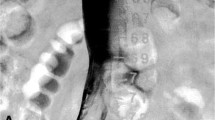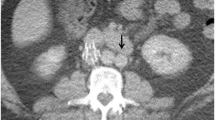Abstract
The purpose of this paper is to report on the histology of tissues found on retrieved filters with regard to indwelling time. Between February 2006 and January 2007, 28 Optease inferior vena cava filters (Cordis Europa, Roden, The Netherlands) were retrieved from 27 patients. Twenty-two filters were inserted prophylactically for trauma patients and six for patients with venous thromboembolism. Cavography was performed both before and after filter removal to evaluate the presence of thrombi or wall damage. Filters were retrieved with the snare and sheath method. All material adherents to the filters were examined histologically.
The mean indwelling time of the filters was 24.9 days (range, 6–69 days). Red tissue fragments were seen on all the filters, consistent microscopically with clots and fibrin. On five filters (18%; mean indwelling time, 45.4 days) white tissue consistent with vascular intima was found. All postprocedure cavographies were normal. We conclude that most material adherent to the retrieved filters is thrombi, while vascular intima can be found in the minority of filters with a longer indwelling time.

Similar content being viewed by others
References
Morris CS, Rogers FB, Najarian KE, Bhave AD, Shackford SR (2004) Current trends in vena caval filtration with the introduction of a retrievable filter at a level I trauma center. J Trauma 57:32–36
Keller IS, Meier C, Pfiffner R, Keller E, Pfammatter T (2007) Clinical comparison of two optional vena cava filters. J Vasc Interv Radiol 18:505–511
Looby S, Given MF, Geoghegan T, McErlean A, Lee MJ (2007) Gunther Tulip retrievable inferior vena caval filters: indications, efficacy, retrieval, and complications. CardioVasc Interv Radiol 30:59–65
Ray CE Jr, Mitchell E, Zipser S et al (2006) Outcomes with retrievable inferior vena cava filters: a multicenter study. J Vasc Interv Radiol 17:1595–1604
Asch MR (2002) Initial experience in humans with a new retrievable inferior vena cava filter. Radiology 225:835–844
Yamagami T, Kato T, Hirota T, Yoshimatsu R, Matsumoto T, Nishimura T (2007) Evaluation of retrievability of the Gunther Tulip vena cava filter. CardioVasc Interv Radiol 30:226–231
Meier C, Keller IS, Pfiffner R, Labler L, Trentz O, Pfammatter T (2006) Early experience with the retrievable OptEase vena cava filter in high-risk trauma patients. Eur J Vasc Endovasc Surg 32:589–595
Oliva VL, Szatmari F, Giroux MF, Flemming BK, Cohen SA, Soulez G, MD (2005) The Jonas study: evaluation of the retrievability of the Cordis OptEase inferior vena cava filter. J Vasc Interv Radiol 16:1439–1445
Millward SF, Bhargava A, Aquino J et al (2000) Günther Tulip filter: preliminary clinical experience with retrieval. J Vasc Interv Radiol 11:75–82
Piano G, Ketteler ER, Prachand V et al (2007) Safety, feasibility, and outcome of retrievable vena cava filters in high-risk surgical patients. J Vasc Surg 45:784–788
Imberti D, Bianchu M, Farina A, Siragusa S, Silingardi M, Ageno W (2004) Clinical experience with retrievable vena cava filters: results of a prospective observational multicenter study. J Vasc Interv Radiol 15:261–267
Rosenthal D, Wellons ED, Lai KM, Bikk A, Henderson VJ (2006) Retrievable inferior vena cava filters: initial clinical results. Ann Vasc Surg 20:157–165
Rosenthal D, Swischuk JL, Cohen SA, Wellons ED (2005) OptEase retrievable inferior vena cava filter: initial multicenter experience. Vascular 13(5):286–289
Mahrer A, Zippel D, Garniek A et al (2008) Retrievable vena cava filters in major trauma patients: prevalence of thrombus within the filter. Cardiovasc Interv Radiol 31(4):785–789
Cordis (2006) Cordis Optease retrievable vena cava filter. Instructions for use, p 10 (English)
Reekers JA, Hoogeveen YL, Wijnands M, Bosma G, Mulder R, Oliva VL (2004) Evaluation of the retrievability of the OptEase IVC filter in an animal model. J Vasc Interv Radiol 15:261–267
Ashley DW, Mix JW, Christie B et al (2005) Removal of the OptEase retrievable vena cava filter is not feasible after extended time periods because of filter protrusion through the vena cava. J Trauma 59:847–852
Gatti AM, Montanari S (2006) Retrieval analysis of clinical explanted vena cava filters. J Biomed Mater Res Part B Appl Biomater 77B:307–314
Kaufman JA, Kinney TB, Streiff MB et al (2007) Guidelines for the use of retrievable and convertible vena cava filters: report from the society of interventional radiology multidisciplinary consensus conference. World J Surg 31:251–264
Author information
Authors and Affiliations
Corresponding author
Rights and permissions
About this article
Cite this article
Rimon, U., Volkov, A., Garniek, A. et al. Histology of Tissue Adherent to OptEase Inferior Vena Cava Filters Regarding Indwelling Time. Cardiovasc Intervent Radiol 32, 93–96 (2009). https://doi.org/10.1007/s00270-008-9423-4
Received:
Revised:
Accepted:
Published:
Issue Date:
DOI: https://doi.org/10.1007/s00270-008-9423-4




